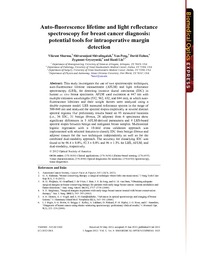| dc.contributor.author | Sharma, Vikrant | |
| dc.contributor.author | Shivalingaiah, Shivaranjani | |
| dc.contributor.author | Peng, Yan | |
| dc.contributor.author | Euhus, David | |
| dc.contributor.author | Gryczynski, Zygmunt | |
| dc.contributor.author | Liu, Hanli | |
| dc.date.accessioned | 2017-02-23T20:18:26Z | |
| dc.date.available | 2017-02-23T20:18:26Z | |
| dc.date.issued | 2012-08-01 | |
| dc.identifier.citation | Published in Biomedical Optics Express 3(8): 1825, 2012 | en_US |
| dc.identifier.uri | http://hdl.handle.net/10106/26467 | |
| dc.description | The authors thank Dr. Georgios Alexandrakis and Dr. Digant Dave from UT Arlington, for helpful discussions on AFLM measurements. The authors are grateful to Dr. Ignacy Gryczynski from the University of North Texas Health Science Center for his technical suggestions. Also, we thank Dr. Nancy Rowe from UT Arlington for statistics support in mixed model analysis. | en_US |
| dc.description.abstract | This study investigates the use of two spectroscopic techniques,
auto-fluorescence lifetime measurement (AFLM) and light reflectance
spectroscopy (LRS), for detecting invasive ductal carcinoma (IDC) in
human ex vivo breast specimens. AFLM used excitation at 447 nm with
multiple emission wavelengths (532, 562, 632, and 644 nm), at which autofluorescence lifetimes and their weight factors were analyzed using a
double exponent model. LRS measured reflectance spectra in the range of
500-840 nm and analyzed the spectral slopes empirically at several distinct
spectral regions. Our preliminary results based on 93 measured locations
(i.e., 34 IDC, 31 benign fibrous, 28 adipose) from 6 specimens show
significant differences in 5 AFLM-derived parameters and 9 LRS-based
spectral slopes between benign and malignant breast samples. Multinomial
logistic regression with a 10-fold cross validation approach was
implemented with selected features to classify IDC from benign fibrous and
adipose tissues for the two techniques independently as well as for the
combined dual-modality approach. The accuracy for classifying IDC was
found to be 96.4 ± 0.8%, 92.3 ± 0.8% and 96 ± 1.3% for LRS, AFLM, and
dual-modality, respectively. | |
| dc.language.iso | en_US | en_US |
| dc.publisher | OSA Publishing | en_US |
| dc.subject | Spectroscopic techniques | en_US |
| dc.subject | Auto-fluorescence lifetime measurement (AFLM) | en_US |
| dc.subject | Light reflectance spectroscopy | en_US |
| dc.subject | Optical diagnostics for medicine | en_US |
| dc.title | Auto-fluorescence lifetime and light reflectance spectroscopy for breast cancer diagnosis: potential tools for intraoperative margin detection | en_US |
| dc.type | Article | en_US |
| dc.publisher.department | Department of Bioengineering, The University of Texas at Arlington | en_US |
| dc.identifier.externalLinkDescription | The original publication is available at Article DOI | en_US |
| dc.identifier.doi | https://doi.org/10.1364/BOE.3.001825 | |

